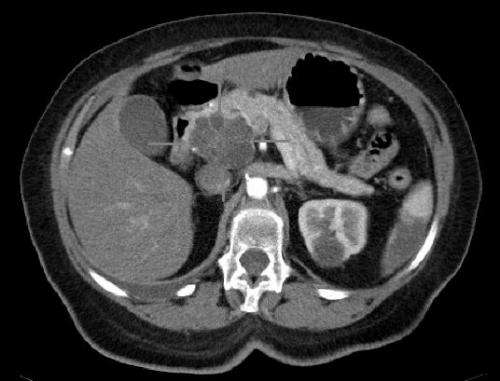Axial CT image with i.v. contrast. Macrocystic adenocarcinoma of the pancreatic head. Credit: public domain
Pancreatic cancer is one of the most aggressive tumour types because it starts forming metastases early. The cancer itself, however, is usually only discovered late. This leads to a high patient mortality rate. Researchers at Friedrich-Alexander-Universität Erlangen-Nürnberg (FAU) have now discovered why pancreatic cancer and other malignant types of tumours can disseminate so rapidly. The results have now been published in the renowned journal Nature Cell Biology.
The FAU researchers led by Prof. Dr Thomas Brabletz and Dr. Marc Stemmler of the Chair of Experimental Medicine I, with the cooperation of the Department of Medicine 5 - Haematology and Oncology, the Department of Surgery at Universitätsklinikum Erlangen, and the Chair of Genetics at the Faculty of Sciences, have discovered that this aggressive type of tumour activates the key factor of an embryonic programme. This factor, called Zeb1, controls how cells migrate and survive in early embryonic development. Zeb1 is blocked in normal, fully developed cells. But when the factor is re-activated in cancer cells, it has fatal consequences: The tumour cells disseminate throughout the body and quickly adapt to the changing conditions in their new environment. They can then develop into metastases and form secondary tumours. The cancer assumes an aggressive progression.
If, however, Zeb1 is not activated, cancer cells can no longer adapt to their new environment so easily. This in turn leads to the development of a variant of pancreatic cancer which presents significantly lower metastatic capacity. This mechanism is also observed in other tumours, such as aggressive forms of breast cancer. The researchers now hope these findings will help them to develop new treatment strategies for combating metastases of pancreatic cancer and other aggressive tumour types.
More information: Angela M. Krebs et al, The EMT-activator Zeb1 is a key factor for cell plasticity and promotes metastasis in pancreatic cancer, Nature Cell Biology (2017). DOI: 10.1038/ncb3513
Journal information: Nature Cell Biology
Provided by University of Erlangen-Nuremberg





















